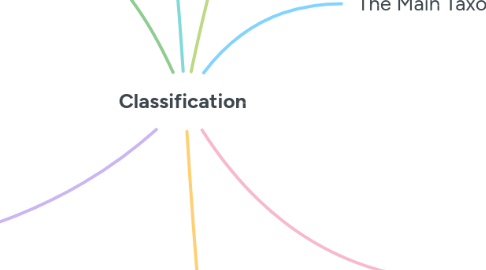
1. The Binomial System
1.1. A naming system devised by Linnaeus where every organism is given 2 Latin names — first for the genus and second for the species
1.2. Rules
1.2.1. Use italics
1.2.2. The first (genus) name has an uppercase letter and the second (species) a lowercase one
1.2.3. After the first use, binomial names are abbreviated to the initial of the genus and then the species name
2. The Main Taxonomic Groups
2.1. Domain, Kingdom, Phylum (Animals) or Division (Plants), Class, Order, Family, Genus, Species
2.1.1. Archae
2.1.1.1. Archaebacteria
2.1.1.1.1. Ancient bacteria usually found in extreme environments
2.1.2. Eukaryota
2.1.2.1. Protista
2.1.2.1.1. Diverse group of microscopic organisms; includes heterotrophs and autotrophs
2.1.2.2. Fungi
2.1.2.2.1. Heterotrophs with chitin in their cell walls; saprophytic and parasitic
2.1.2.3. Plantae
2.1.2.3.1. Almost all are autotrophs by photoshynthesis
2.1.2.4. Animalia
2.1.2.4.1. All heterotrophs that move their bodies around at least during one stage of their life cycle; includes vertebrates and invertebrates
2.1.3. Bacteria
2.1.3.1. Eubacteria
2.1.3.1.1. True bacteria: causes disease, help in digestive systems and recycling nutrients in the environment.
3. The Importance of Classification
3.1. To ensure uniform reference when various countries are talking about an organism
3.2. To monitor changes in the populations of different types of organism
3.3. To identify and differentiate various organisms correctly, including from their origins and evolutions
3.4. To help in understanding of how different types of living organisms are related to each other (ancestral relationships)
4. The Concept of Species
4.1. The Morphological Species Concept
4.1.1. Is the original model developed by Linnaeus.
4.1.2. Species are classified based on their appearance; outer and inner morphology
4.1.3. A downside is that organism's appearances can be easily impacted and there can even be sexual dismorphism, making hard for this concept to be applied
4.2. The Reproductive or Biological Species Concept
4.2.1. 1st Definition: Organisms with same species have similar characteristics and are potentially capable of breeding to produce a fertile offspring.
4.2.2. 2nd Definition: Those with the same species are a group of organisms in which genes can flow between the individuals.
4.2.3. A drawback is that it's less helpful in classifying plants, which often interbreed with similar species.
5. High to Low
6. Other Definitions of Species
6.1. Ecological Species Model
6.1.1. Based on the ecological niche occupied by an organism.
6.1.1.1. (-) Niche definitions are variative and many species may occupy more than one niche.
6.2. Mate-recognition Species Model
6.2.1. Based on unique fertilisation systems and mating behaviour.
6.2.1.1. (-) Many species may mate with each other and produce fertile offspring despite being different species to each other.
6.3. Genetic Species Model
6.3.1. Based on DNA evidence.
6.3.1.1. (-) There is no standard yet on how much genetic difference is needed to be classified as different species. It is also difficult, expensive, and cost a lot of money.
